
Date: November 16, 2019
Location: Lat: 24.762667°, Long: -80.144817°
Dive Depth Range: 590 - 641 meters (1,936 - 2,103 feet)
Access Dive Summary and ROV Data
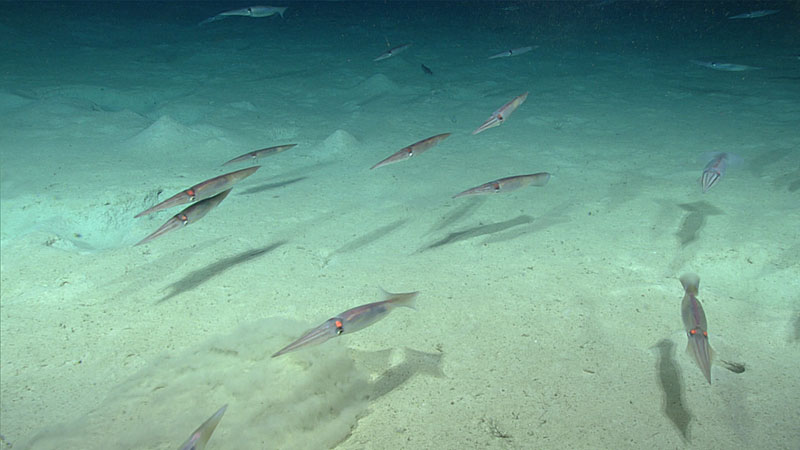
These troublemaking squid were our constant companions during Dive 09 of the 2019 Southeastern U.S. Deep-sea Exploration, stirring up sediment and casting shadows as they zoomed in front of our cameras. Image courtesy of the NOAA Office of Ocean Exploration and Research, 2019 Southeastern U.S. Deep-sea Exploration. Download larger version (jpg, 739 KB).
Another great day to dive. Today we explored an area south of the Florida Keys in the Straits of Florida. Given the changes we made to our operations because of the challenges posed by the weather, waves, and currents, we found ourselves in an area where we needed more information to support our dive planning. So, we took the opportunity to fill in some more mapping gaps and conducted a “map and dive,” which means we mapped an area overnight and dove on it the next day.
After a slight delay, we launched the remotely operated vehicles and descended to the flat and sedimented seafloor. Throughout the dive, the landscape was dotted with depressions and volcano-shaped piles of sediment. These features are evidence of the presence of burrowing organisms such as crustaceans and possibly fish.
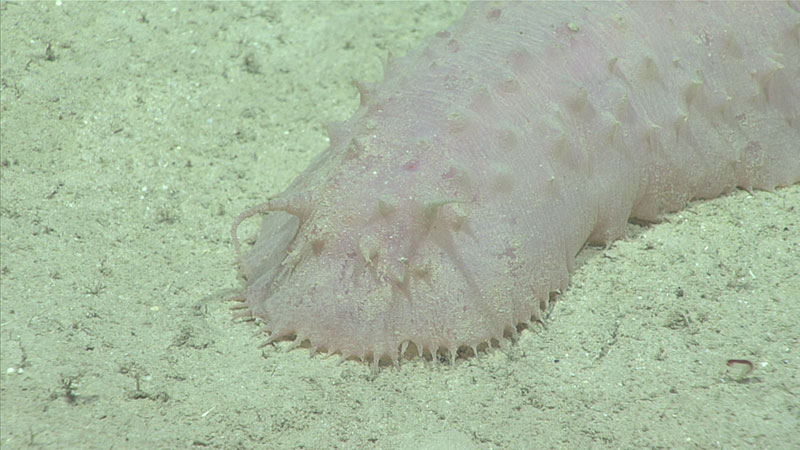
This pink sea cucumber (Holothuria) was spotted during Dive 09 of the 2019 Southeastern U.S. Deep-sea Exploration. Image courtesy of the NOAA Office of Ocean Exploration and Research, 2019 Southeastern U.S. Deep-sea Exploration. Download larger version (jpg, 935 KB).
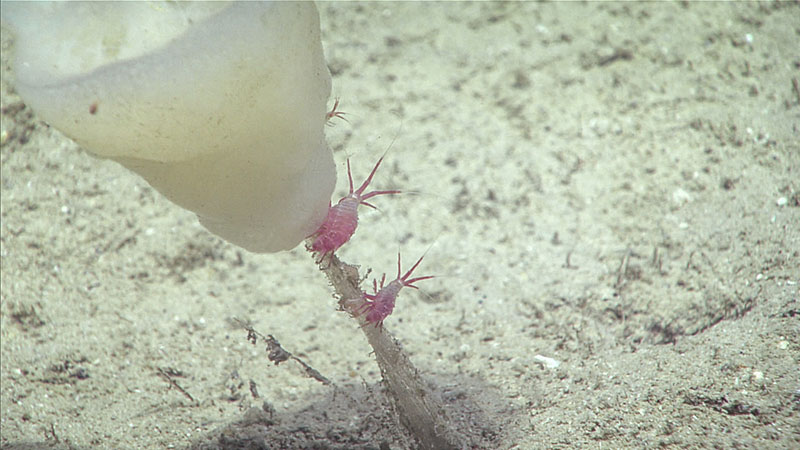
Seen here during Dive 09 of the 2019 Southeastern U.S. Deep-sea Exploration, some amphipods (Amathillopsidae) perched on the spicules of a glass sponge (Hyalonema). Image courtesy of the NOAA Office of Ocean Exploration and Research, 2019 Southeastern U.S. Deep-sea Exploration. Download larger version (jpg, 952 KB).
We were surprised by how much life was present in this sedimented area. Some of the animals we saw on this dive included squids (in abundance and including some bobtails), a spoonarm octopus, a variety of shrimps (e.g., royal red shrimp and armored shrimp), squat lobsters, a mating pair of golden crabs, lobsters, armored sea robins, codlings, underworld skates, marbled catsharks, tripod fish, cookie stars, long armed brittle stars, feather stars, sea cucumbers, and more.
We didn’t see a lot of corals, likely due to the lack of hard surfaces for them to attach to, but we did see some sea pens and a number of individuals that we believe to be Acanella that were each accompanied by a single purple scale worm (polychaete) at their base. Similarly, we didn’t see a lot of sponge diversity, but we did see some very interesting species. For the second day in a row, we saw and collected some interesting carnivorous demosponges (two different species from the genus Chondrocladia) that were unfamiliar to our scientists and may represent new species.
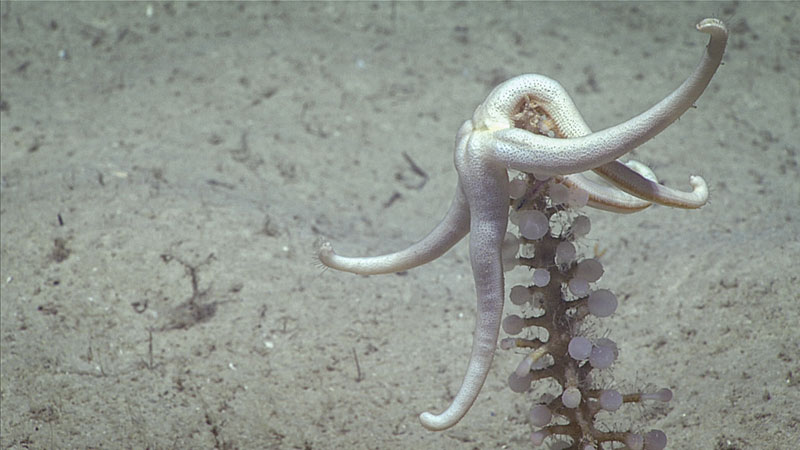
Predation events always generate a lot of excitement among our scientists. This one observed during Dive 09 of the 2019 Southeastern U.S. Deep-sea Exploration was particularly interesting because it featured an unidentified Henricia sea star feeding on a Chondrocladia carnivorous sponge. Image courtesy of the NOAA Office of Ocean Exploration and Research, 2019 Southeastern U.S. Deep-sea Exploration. Download larger version (jpg, 809 KB).
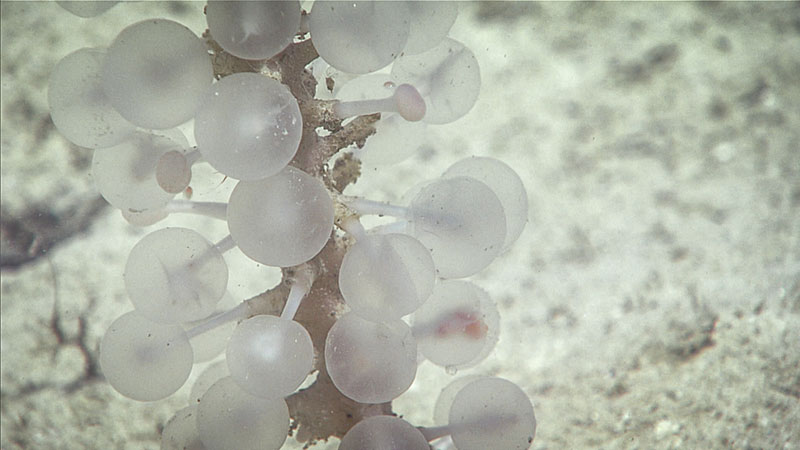
This carnivorous demosponge was one of two collected from the genus Chondrocladia during Dive 09 of the 2019 Southeastern U.S. Deep-sea Exploration as possible new species. Image courtesy of the NOAA Office of Ocean Exploration and Research, 2019 Southeastern U.S. Deep-sea Exploration. Download larger version (jpg, 794 KB).
Few days pass without observing an interesting or unprecedented behavior. One of today’s highlights was undoubtedly watching a Henricia sea star feeding on a carnivorous sponge. We found this so intriguing that we collected them both to see what we can learn about the two animals and their relationship. Another fascinating behavior was displayed by a sea pen (Calibelemnon) that, when intentionally prodded by Deep Discoverer’s manipulator arm, retracted into a burrow in the seafloor. Scientists are curious about this behavior, particularly how it is they’re able to retract and if the behavior is specific to certain species of sea pens.
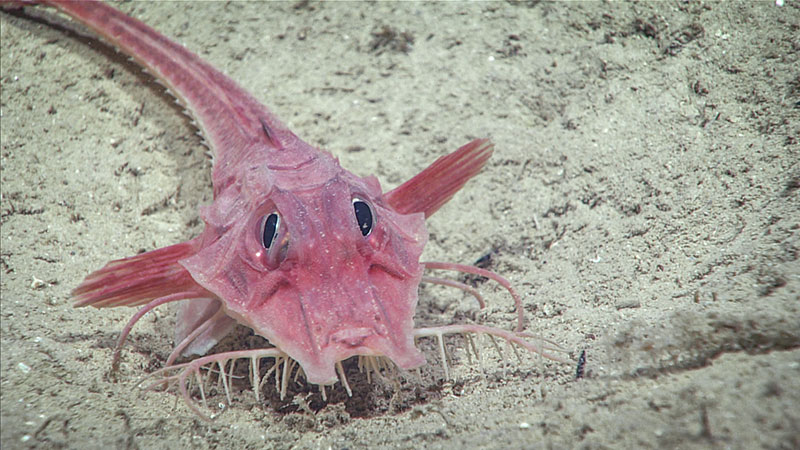
A number of these unusual looking creatures were seen on the seafloor during Dive 09 of the 2019 Southeastern U.S. Deep-sea Exploration. These armored searobins (Triglidae) use modified fins to move across the seafloor and branched "whiskers" in front of their mouths to help them sense food. Image courtesy of the NOAA Office of Ocean Exploration and Research, 2019 Southeastern U.S. Deep-sea Exploration. Download larger version (jpg, 1.2 MB).

Location of Dive 09 of the 2019 Southeastern U.S. Deep-sea Exploration on November 16, 2019. Download larger version (jpg, 1.8 MB).
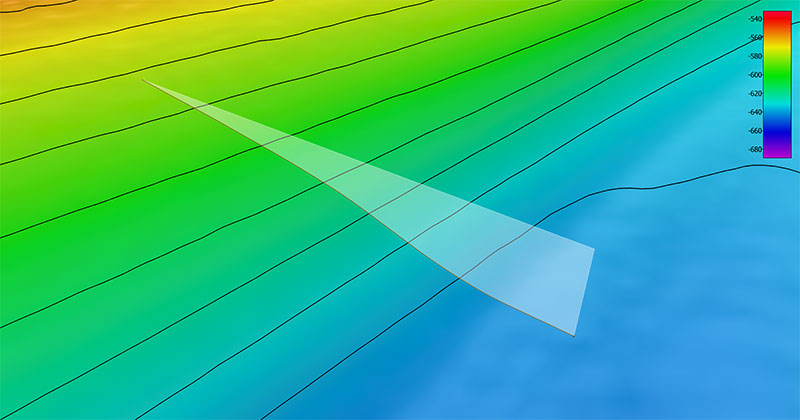
The remotely operated vehicle track for Dive 09 of the 2019 Southeastern U.S. Deep-sea Exploration, shown as an orange line with a white curtain. The Mapping Team collected this data the night before the dive. Legend shows water depth in meters. Download larger version (jpg, 2.3 MB).